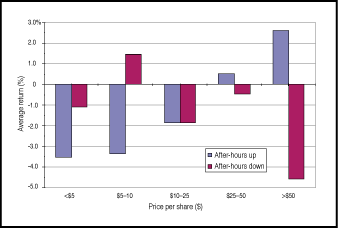Profit Between Sessions
After-Hours Trading
by Victoria Wang
Stock prices tend to fluctuate dramatically after the market close, when companies release important news or statements. Find out how you can understand and determine the relationship between after-hours activity and the following day's closing price.
After-hours trading" refers to trading activity that takes place after normal trading hours from 9:30 am to 4:00 pm Eastern time. With the development of electronic communication networks (ECNs) and the availability of online after-hour trading provided by brokerage firms, investors and traders are able to take part in after-hours trading. Stock prices tend to fluctuate dramatically during the after-hours period when companies release important news or statements following the market's close. Poor earnings announcements or other unfavorable news may immediately drive the price down significantly. Conversely, good news may boost demands for the stock. Understanding and determining the relationship between an after-hours price movement and the following day's closing price will provide valuable information to savvy traders. This article studies the effect of an after-hours price movement on the next day's closing for the underlying stocks. It is the second of a systematic study of stock market price patterns. (See my July 2007 S&C article for the first.)
DATA COLLECTION
After-hours trading activity was analyzed from a dataset collected between February 8, 2006, and June 21, 2007. It was downloaded from the NASDAQ website every evening after the close of after-hours trading. The collected data includes the price of the stock at the close of after-hours trading, termed "current price," the price percentage change of its current price relative to its closing price that day at 4:00 pm, the after-hours trading volume, and the following day's closing price during normal trading hours.
Here, I focus on the effect of after-hours trading price, price percentage change, and after-hours trading volume. A winning trade is defined as one that returns at least 0.5%. As a threshold, the choice of 0.5% is arbitrary. However, after-hours trading often involves large slippages in stock price, so we use this level to take into account such slippage and fees related to trading, including commissions and SEC fees.

FIGURE 1: EFFECT OF PRICE ON AVERAGE RETURN. Blue bars indicate stocks that were up in after-hours trading; maroon bars indicate stocks that were down in after-hours trading. All stocks have an after-hours trading volume greater than or equal to 100,000 and a price percentage change of at least 10% during the after-hours trading period....Continued in the July issue of Technical Analysis of STOCKS & COMMODITIES
Excerpted from an article originally published in the July 2008 issue of Technical Analysis of STOCKS & COMMODITIES magazine. All rights reserved. © Copyright
2008, Technical Analysis, Inc.
Return to July 2008 Contents